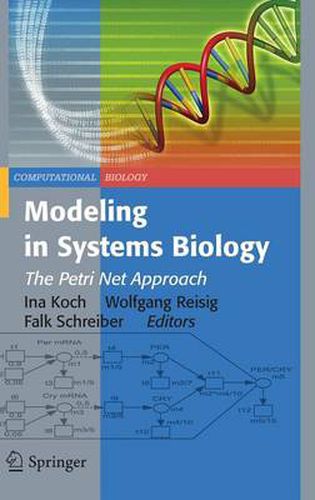Readings Newsletter
Become a Readings Member to make your shopping experience even easier.
Sign in or sign up for free!
You’re not far away from qualifying for FREE standard shipping within Australia
You’ve qualified for FREE standard shipping within Australia
The cart is loading…






This title is printed to order. This book may have been self-published. If so, we cannot guarantee the quality of the content. In the main most books will have gone through the editing process however some may not. We therefore suggest that you be aware of this before ordering this book. If in doubt check either the author or publisher’s details as we are unable to accept any returns unless they are faulty. Please contact us if you have any questions.
The emerging, multi-disciplinary field of systems biology is devoted to the study of the relationships between various parts of a biological system, and computer modeling plays a vital role in the drive to understand the processes of life from an holistic viewpoint. Advancements in experimental technologies in biology and medicine have generated an enormous amount of biological data on the dependencies and interactions of many different molecular cell processes, fueling the development of numerous computational methods for exploring this data. The mathematical formalism of Petri net theory is able to encompass many of these techniques.
This essential text/reference presents a comprehensive overview of cutting-edge research in applications of Petri nets in systems biology, with contributions from an international selection of experts. Those unfamiliar with the field are also provided with a general introduction to systems biology, the foundations of biochemistry, and the basics of Petri net theory. Further chapters address Petri net modeling techniques for building and analyzing biological models, as well as network prediction approaches, before reviewing the applications to networks of different biological classification.
Topics and features: investigates the modular, qualitative modeling of regulatory networks using Petri nets, and examines an Hybrid Functional Petri net simulation case study; contains a glossary of the concepts and notation used in the book, in addition to exercises at the end of each chapter; covers the topological analysis of metabolic and regulatory networks, the analysis of models of signaling networks, and the prediction of network structure; provides a biological case study on the conversion of logical networks into Petri nets; discusses discrete modeling, stochastic modeling, fuzzy modeling, dynamic pathway modeling, genetic regulatory network modeling, and quantitative analysis techniques; includes a Foreword by Professor Jens Reich, Professor of Bioinformatics at Humboldt University and Max Delbruck Center for Molecular Medicine in Berlin.
This unique guide to the modeling of biochemical systems using Petri net concepts will be of real utility to researchers and students of computational biology, systems biology, bioinformatics, computer science, and biochemistry.
$9.00 standard shipping within Australia
FREE standard shipping within Australia for orders over $100.00
Express & International shipping calculated at checkout
This title is printed to order. This book may have been self-published. If so, we cannot guarantee the quality of the content. In the main most books will have gone through the editing process however some may not. We therefore suggest that you be aware of this before ordering this book. If in doubt check either the author or publisher’s details as we are unable to accept any returns unless they are faulty. Please contact us if you have any questions.
The emerging, multi-disciplinary field of systems biology is devoted to the study of the relationships between various parts of a biological system, and computer modeling plays a vital role in the drive to understand the processes of life from an holistic viewpoint. Advancements in experimental technologies in biology and medicine have generated an enormous amount of biological data on the dependencies and interactions of many different molecular cell processes, fueling the development of numerous computational methods for exploring this data. The mathematical formalism of Petri net theory is able to encompass many of these techniques.
This essential text/reference presents a comprehensive overview of cutting-edge research in applications of Petri nets in systems biology, with contributions from an international selection of experts. Those unfamiliar with the field are also provided with a general introduction to systems biology, the foundations of biochemistry, and the basics of Petri net theory. Further chapters address Petri net modeling techniques for building and analyzing biological models, as well as network prediction approaches, before reviewing the applications to networks of different biological classification.
Topics and features: investigates the modular, qualitative modeling of regulatory networks using Petri nets, and examines an Hybrid Functional Petri net simulation case study; contains a glossary of the concepts and notation used in the book, in addition to exercises at the end of each chapter; covers the topological analysis of metabolic and regulatory networks, the analysis of models of signaling networks, and the prediction of network structure; provides a biological case study on the conversion of logical networks into Petri nets; discusses discrete modeling, stochastic modeling, fuzzy modeling, dynamic pathway modeling, genetic regulatory network modeling, and quantitative analysis techniques; includes a Foreword by Professor Jens Reich, Professor of Bioinformatics at Humboldt University and Max Delbruck Center for Molecular Medicine in Berlin.
This unique guide to the modeling of biochemical systems using Petri net concepts will be of real utility to researchers and students of computational biology, systems biology, bioinformatics, computer science, and biochemistry.